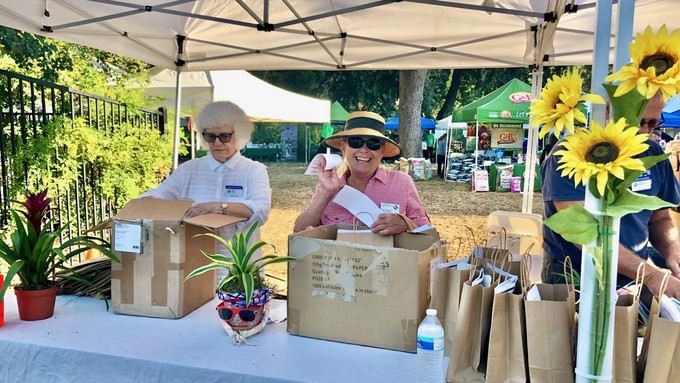
Weather roller-coaster continues; triple-digit temperatures return this weekend

At Harvest Day 2022, master gardeners Peggy Ruud, left, and Debi Brakebill were among the greeters handing out gift bags at the Fair Oaks Horticulture Center. Visitors at Harvest Day this Saturday also will receive gift bags. Kathy Morrison
We’re riding a weather roller-coaster. After another warm weekend to end July, temperatures are expected to dip into the low 80s for parts of the greater Sacramento area before returning to triple digits by week’s end -- and Harvest Day.
Saturday’s forecast will be in the range of 97 to 105 degrees, says the National Weather Service. Sunday will be even hotter.
Harvest Day, the Sacramento region's biggest free gardening event, is scheduled for 8 a.m. to 2 p.m., Saturday, Aug. 5, at Fair Oaks Horticulture Center in Fair Oaks Park. The forecast high: 102 degrees at 5 p.m.
The first week of August follows a yo-yo weather pattern of temperature dips and spikes that we’ve seen all summer, including four times in July. We saw record highs (107 each time) on July 1 and July 16, but we also saw record overnight lows (53 twice) on July 9 and 10. (The high on July 9 was an almost-shivery 76 degrees.)
The warmer days outnumbered the below-average ones; 17 days recorded highs above average for their dates. July’s high temperatures averaged 94.3 – almost two degrees above average for this month in Sacramento.
“Remember, even normal temperatures this time of year are still quite warm and can cause heat-related illnesses,” tweeted the NWS Sacramento office on Monday morning. “Be sure to stay cool & hydrated!”
Compared to other places, Sacramento got off easy during what will be remembered as a red-hot July. Climate scientists estimate that July 2023 is the hottest month ever recorded on Earth with three continents – North America, Europe and Asia – experiencing deadly heat waves. Last week, heat advisories or warnings were issued for the home communities of more than 128 million Americans.
Some heat has been truly extreme: Phoenix recorded highs of 110 degrees or hotter every single day in July, hitting 119 degrees three times. Helping to maintain that record heat, overnight lows stayed above 90 degrees on 19 nights.
Fortunately for the greater Sacramento area, August is expected to be a more normal month with most days in the low to mid 90s – thanks to the Delta breeze.
Those lower temperatures literally take the heat off our tomatoes, peppers and other summer crops. It still will be warm enough for steady ripening and harvest, but cool enough for these plants to also set more fruit. For example, tomatoes need temperatures below 95 degrees to set.
Keep your garden evenly hydrated – not too wet but never completely dry. Provide afternoon shade if possible for developing tomatoes, peppers and eggplant.
And start planning and planting for fall; those little lettuce seeds sprout faster in warm soil.
For more on Sacramento weather: https://www.weather.gov/sto/.
Comments
0 comments have been posted.Sacramento Digs Gardening to your inbox.
Food in My Back Yard Series
April 1: Don't be fooled by these garden myths
March 25: Fertilizer tips: How to 'feed' your vegetables for healthy growth
March 18: Time to give vegetable seedlings some more space
March 11: Ways to win the fight against weeds
March 4: Potatoes from the garden
Feb. 25: Plant a fruit tree now -- for later
Feb. 18: How to squeeze more food into less space
Feb. 11: When to plant? Consider staggering your transplants
Feb. 4: Starting in seed starting
Sites We Like
Garden Checklist for week of March 30
Your garden doesn’t mind April showers. Get busy now to enjoy those future flowers.
* Get ready to swing into action in the vegetable garden. As nights warm up over 50 degrees, start setting out tomato, pepper and eggplant transplants.
* From seed, plant beans, beets, cantaloupes, carrots, corn, cucumbers, melons, pumpkins, radishes and squash. (Soak beet seeds overnight in water for better germination,)
* Plant onion sets.
* In the flower garden, plant seeds for asters, cosmos, celosia, marigolds, salvia, sunflowers and zinnias.
* Transplant petunias, zinnias, geraniums and other summer bloomers.
* Plant perennials and dahlia tubers for summer bloom.
* Transplant lettuce and cabbage seedlings.
* April is the last chance to plant citrus trees such as dwarf orange, lemon and kumquat. These trees also look good in landscaping and provide fresh fruit in winter.
* Smell orange blossoms? Feed citrus trees with a low dose of balanced fertilizer (such as 10-10-10) during bloom to help set fruit. Keep an eye out for ants.
* Apply slow-release fertilizer to the lawn.